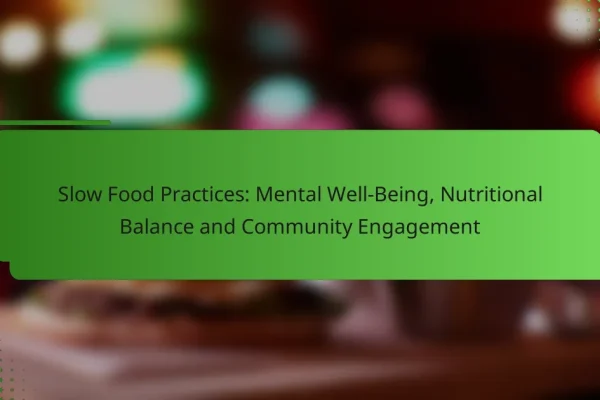How does Slow Food promote health and wellness?
Slow Food promotes health and wellness by prioritizing nutritious, fresh ingredients and encouraging mindful eating practices. This approach not only enhances physical health but also fosters a deeper connection to food and the environment.
Emphasis on fresh ingredients
Fresh ingredients are fundamental to the Slow Food movement, as they retain more nutrients and flavor compared to processed alternatives. Choosing seasonal fruits and vegetables can significantly enhance the taste and health benefits of meals.
For example, incorporating a variety of colorful vegetables into your diet can provide essential vitamins and minerals. Aim to fill half your plate with fresh produce at each meal for optimal health benefits.
Focus on local sourcing
Local sourcing supports community farmers and reduces the carbon footprint associated with transporting food. Eating locally often means accessing fresher, more flavorful ingredients that are in season.
Consider visiting farmers’ markets or joining a community-supported agriculture (CSA) program to obtain fresh, local produce. This not only benefits your health but also strengthens local economies.
Encouragement of mindful eating
Mindful eating involves paying attention to the experience of eating, including the taste, texture, and aroma of food. This practice can help individuals develop a healthier relationship with food and recognize hunger and fullness cues.
To practice mindful eating, try to eliminate distractions during meals, such as screens or multitasking. Focus on each bite and savor the flavors, which can lead to greater satisfaction and potentially reduced overeating.
Reduction of processed foods
Reducing processed foods is a key principle of Slow Food, as these items often contain unhealthy additives, preservatives, and high levels of sugar and salt. By minimizing processed foods, individuals can improve their overall diet quality.
Start by replacing processed snacks with whole foods like fruits, nuts, or yogurt. Gradually shift your meals to include more home-cooked dishes made from whole ingredients, aiming for a balanced diet rich in nutrients.
Support for sustainable practices
Slow Food emphasizes sustainability by encouraging practices that protect the environment and promote biodiversity. This includes supporting organic farming, reducing food waste, and choosing products with minimal packaging.
To support sustainable practices, consider growing your own herbs or vegetables, composting food scraps, and choosing products certified as organic or fair trade. These actions contribute to a healthier planet and a healthier you.
What are the health benefits of Slow Food?
Slow Food promotes a holistic approach to eating that can lead to various health benefits. By emphasizing local, seasonal, and sustainably sourced ingredients, it encourages better nutrition, mental well-being, and stronger community ties.
Improved nutrition
Slow Food prioritizes fresh, whole ingredients, which can significantly enhance nutritional intake. Meals prepared with seasonal produce are often richer in vitamins and minerals compared to processed foods. This approach encourages a diet high in fruits, vegetables, whole grains, and lean proteins.
To maximize nutritional benefits, focus on incorporating a variety of colors on your plate, as different colors often represent different nutrients. Aim for meals that include a mix of greens, reds, yellows, and purples to ensure a broad spectrum of vitamins and antioxidants.
Enhanced mental well-being
Engaging with Slow Food practices can lead to improved mental health by fostering mindfulness and reducing stress. Taking the time to prepare and enjoy meals can create a calming routine, allowing individuals to disconnect from daily pressures.
Additionally, the social aspect of sharing meals with family and friends can enhance emotional connections, contributing to overall happiness. Consider setting aside regular times for communal meals to strengthen these bonds and promote a sense of belonging.
Stronger community connections
Slow Food encourages local food systems, which can strengthen community ties. By supporting local farmers and markets, individuals contribute to the local economy and foster relationships with food producers. This creates a sense of shared responsibility and connection within the community.
Participating in community-supported agriculture (CSA) programs or local food events can deepen these connections. Engaging with neighbors and local producers not only enhances your food experience but also builds a resilient community network.
How can I incorporate Slow Food principles into my diet?
Incorporating Slow Food principles into your diet involves prioritizing local, seasonal, and sustainably sourced foods. This approach not only enhances your health but also supports local economies and reduces environmental impact.
Choose seasonal produce
Choosing seasonal produce means selecting fruits and vegetables that are harvested at their peak ripeness. This not only ensures better flavor but also maximizes nutritional value. For example, in the summer, opt for tomatoes and berries, while in the winter, root vegetables like carrots and potatoes are ideal.
To make the most of seasonal produce, visit local farmers’ markets or join a community-supported agriculture (CSA) program. These options often provide fresher, more flavorful options compared to supermarket offerings.
Join local food co-ops
Joining local food co-ops allows you to access a variety of organic and locally sourced products while supporting your community. Co-ops often offer bulk purchasing options, which can reduce costs and minimize packaging waste.
When selecting a food co-op, look for one that aligns with your values regarding sustainability and community support. Many co-ops also host events and workshops that can deepen your understanding of Slow Food principles.
Participate in community gardens
Participating in community gardens provides an opportunity to grow your own food while fostering community connections. These gardens often emphasize organic practices and can yield a diverse array of vegetables and herbs.
To get involved, seek out local community gardens in your area. Many welcome new members and provide resources for beginners, making it easy to learn about gardening and sustainable food practices.
What are the best Slow Food products available online?
The best Slow Food products available online include artisanal cheeses, organic grains, and locally sourced meats. These items emphasize quality, sustainability, and traditional production methods, making them ideal for health-conscious consumers.
Artisanal cheeses
Artisanal cheeses are crafted using traditional methods, often from local dairies. They typically feature unique flavors and textures that reflect the region’s milk sources and production techniques.
When selecting artisanal cheeses, consider options like aged cheddars, creamy bries, or tangy goat cheeses. Look for products that are made from organic or grass-fed milk to ensure higher quality and better taste.
Organic grains
Organic grains, such as quinoa, farro, and brown rice, are cultivated without synthetic pesticides or fertilizers. These grains are not only healthier but also support sustainable farming practices.
When purchasing organic grains online, check for certifications like USDA Organic. Aim for bulk purchases to save money and reduce packaging waste, and consider trying a variety of grains to diversify your diet.
Locally sourced meats
Locally sourced meats are raised within a specific region, often on small farms that prioritize animal welfare and sustainable practices. This approach typically results in fresher, more flavorful products.
When buying locally sourced meats, look for options like grass-fed beef, pasture-raised chicken, or heritage pork. Check for certifications or labels that indicate humane treatment and sustainable farming methods to ensure quality and ethical sourcing.
How does Slow Food compare to fast food?
Slow food emphasizes quality, sustainability, and local ingredients, while fast food prioritizes speed and convenience. This fundamental difference impacts nutritional value, preparation methods, and overall health benefits.
Nutritional value differences
Slow food typically offers higher nutritional value compared to fast food. Meals prepared with fresh, local ingredients often contain more vitamins, minerals, and antioxidants, while fast food is frequently high in unhealthy fats, sugars, and sodium.
For instance, a slow-cooked vegetable stew made with organic produce can provide essential nutrients and fiber, whereas a fast food burger may contain empty calories and additives. Choosing slow food can lead to better overall health and wellness.
When evaluating options, consider the ingredients and preparation methods. Aim for meals that are rich in whole foods, such as fruits, vegetables, whole grains, and lean proteins, which are more common in slow food. Avoid heavily processed items that dominate fast food menus.









